Mars 2020
[15][16][17] The Mars 2020 mission was announced by NASA in December 2012 at the fall meeting of the American Geophysical Union in San Francisco.
Perseverance's design is derived from the rover Curiosity, and it uses many components already fabricated and tested in addition to new scientific instruments and a core drill.
The Mars 2020 mission was announced by NASA on December 4, 2012, at the fall meeting of the American Geophysical Union in San Francisco.
Some criticized NASA for continuing to focus on Mars exploration instead of other Solar System destinations in constrained budget times.
[21][22] Support came from California U.S. Representative Adam Schiff, who said he was interested in the possibility of advancing the launch date, which would enable a larger payload.
[28] In September 2013, NASA launched an Announcement of Opportunity for researchers to propose and develop the instruments needed, including the Sample Caching System.
[29][30] The science instruments for the mission were selected in July 2014 after an open competition based on the scientific objectives set one year earlier.
It will seek signs of past life, set aside a returnable cache with the most compelling rock core and soil samples, and demonstrate the technology needed for the future human and robotic exploration of Mars.
[34] Improved precision landing technology that enhances the scientific value of robotic missions also will be critical for eventual human exploration on the surface.
[34] The mission will also attempt to identify subsurface water, improve landing techniques, and characterize weather, dust, and other potential environmental conditions that could affect future astronauts living and working on Mars.
[40][41] Between 20 and 30 drilled samples will be collected and cached inside small tubes by the Perseverance rover,[42] and will be left on the surface of Mars for possible later retrieval by NASA in collaboration with ESA.
[39][42] A "fetch rover" would retrieve the sample caches and deliver them to a two-stage, solid-fueled Mars ascent vehicle (MAV).
[44] At a rock named "Wildcat Ridge" located within Jezero's well-preserved sedimentary fan deposit, Perseverance found evidence for an ancient lake environment.
[45]They also found that "sediments entering Jezero's lake were deposited in a delta" and "evidence for late-stage, high-energy flooding that carried large boulders into the crater.
[51] One of the upgrades is a guidance and control technique called "Terrain Relative Navigation" (TRN) to fine-tune steering in the final moments of landing.
[20][59] Engineers redesigned Perseverance's wheels to be more robust than Curiosity's, which, after kilometres of driving on the Martian surface, have shown progressed deterioration.
[64] A Multi-Mission Radioisotope Thermoelectric Generator (MMRTG), left over as a backup part for Curiosity during its construction, was integrated onto the rover to supply electrical power.
[66] Unlike solar panels, the MMRTG does not rely on the presence of the Sun for power, providing engineers with significant flexibility in operating the rover's instruments even at night and during dust storms, and through the winter season.
Space has also been found for the first time for an uncrewed helicopter, which will be controlled by NTNU (Norwegian University of Science and Technology) trained cybernetics engineer Håvard Fjær Grip and his team at NASA's Jet Propulsion Laboratory in Los Angeles.
[74] Jezero today features a prominent river delta where water flowing through it deposited much sediment over the eons, which is "extremely good at preserving biosignatures".
The spacecraft fired thrusters to adjust its course toward Mars, shifting the probe's initial post-launch aim point onto the Red Planet.
The craft from Earth was a carbon fiber capsule that protected the rover and other equipment from heat during entry into the Mars atmosphere and initial guidance towards the planned landing site.
[91] Perseverance successfully landed on the surface of Mars with help of the sky crane on February 18, 2021, at 20:55 UTC, to begin its science phase, and began sending images back to Earth.
[37][111] Adjusted for inflation, Mars 2020 is the sixth-most expensive robotic planetary mission made by NASA and is cheaper than its predecessor, the Curiosity rover.
[118] On February 22, 2021, NASA released uninterrupted footage of the landing process of Mars 2020 from parachute deployment to touchdown in a livestream broadcast.
The parachute's pattern was based on binary code and translated to the motto of JPL (Dare Mighty Things) and the coordinates of its headquarters.

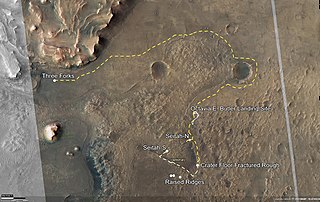


- Mars 2020
- Sun
- Earth
- Mars
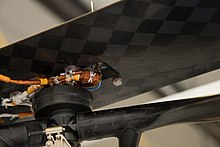
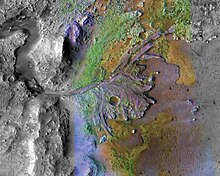
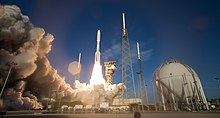
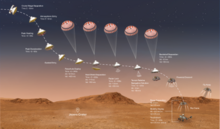
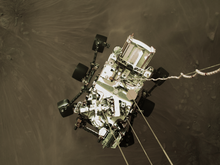

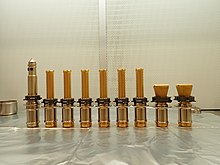
- The pointed one with two windows on the left is the regolith drill
- the two shorter ones on the right are abrasion tools
- the others in the center are rock drills
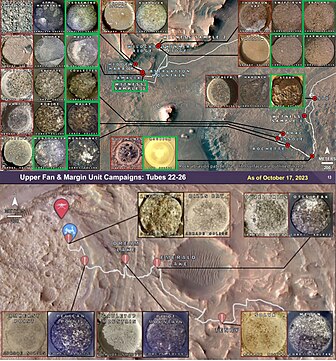
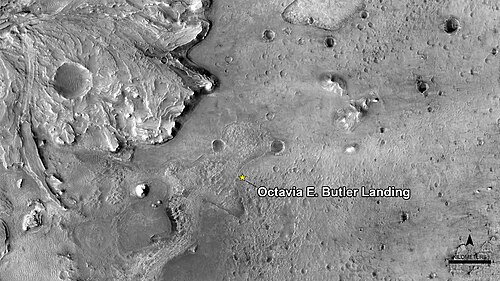



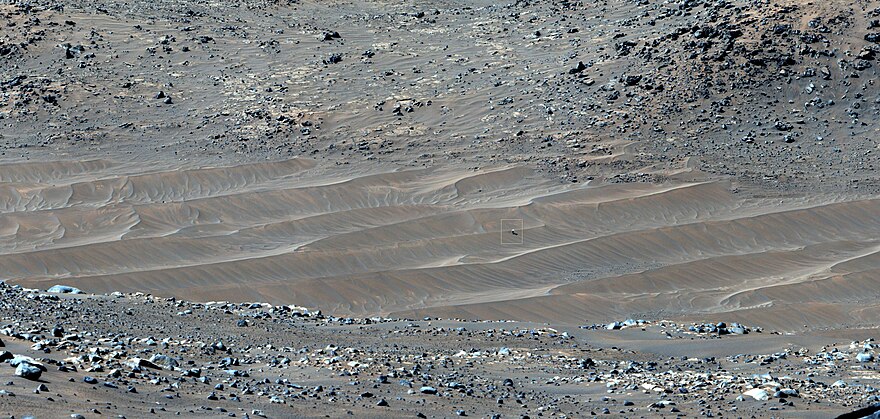
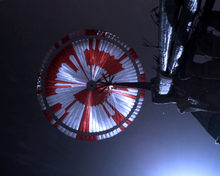

 Clickable image:
Clicking on the labels will open a new article.
Clickable image:
Clicking on the labels will open a new article.



